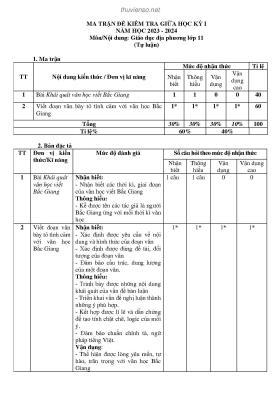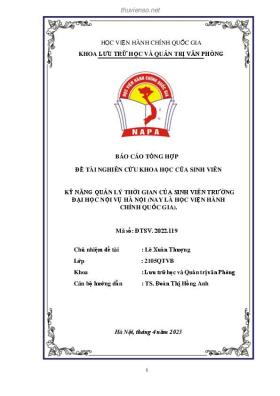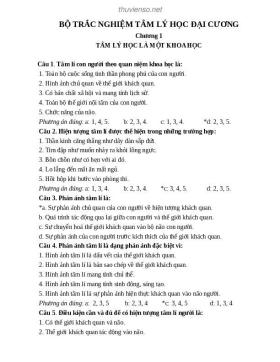
Bài giảng Căn bản về sinh thống kê: Thống kê mô tả
Số trang: 31
Loại file: ppt
Dung lượng: 375.50 KB
Lượt xem: 11
Lượt tải: 0
Xem trước 4 trang đầu tiên của tài liệu này:
Thông tin tài liệu:
Bài giảng cung cấp cho người học các kiến thức: Căn bản về sinh thống kê, thống kê mô tả, thống kê suy lý, quần thể lý thuyết, cách lấy mẫu, thang đo dữ liệu,... Hi vọng đây sẽ là một tài liệu hữu ích dành cho các bạn sinh viên đang theo học môn dùng làm tài liệu học tập và nghiên cứu. Mời các bạn cùng tham khảo chi tiết nội dung tài liệu.
Nội dung trích xuất từ tài liệu:
Bài giảng Căn bản về sinh thống kê: Thống kê mô tả Căn Bản về sinh thống kê Thống kê mô tả Gs, TS LÊ HOÀNG NINH Nội dung cần phân biệt • Distinguish between different strategies for obtaining a sample from a population • Understand the measures of central tendency and variability in your data 2 Thống kê mô tả và suy lý Thống kê mô tả: dùng các con số để tổ chức, biểu thị một bộ dữ liệu từ một mẫu. Thống kê suy lý: có một kết luận từ thông tin chưa hoàn chi3ng, nghĩa là tổng quát hóa kết quả từ một mẫu lên quần thể. Inferential statistics use available information in a sample to draw inferences about the population from which the sample was selected Quần thể lý thuyết Sample 1: Representative? Y N Sample 2: Representative? Y N Sample 3: Representative? Y N 4 Cách lấy mẫu • Convenience Sampling: select the most accessible and available subjects in target population. Inexpensive, less time consuming, but sample is nearly always nonrepresentative of target population. • Random Sampling (Simple): select subjects at random from the target population. Need to identify all in target population first. Provides representative sample frequently. 5 Cách lấy mẫu • Systematic Sampling: Identify all in target population, and select every xth person as a subject. • Stratified Sampling: Identify important sub groups in your target population. Sample from these groups randomly or by convenience. Ensures that important subgroups are included in sample. May not be representative. • More complex sampling 6 Sai lầm do lấy mẫu • Có sự khác biệt giữa trị số trên mẫu ( số thống kê) và trị số thật trên quần thể ( tham số) • Xảy ra ở mọi nghiên cứu. • Sampling error approximates 1 / √n • Note that larger sample sizes also require time and expense to obtain, and that large sample sizes do not eliminate sampling error 7 Research Process Research question Hypothesis Identify research design Data collection Presentation of data Data analysis Interpretation of data 8 Types of Data Collection • Surveys/Questionnaires – Selfreport – Intervieweradministered – proxy • Direct medical examination • Direct measurement (e.g. blood draws) • Administrative records 9 Understanding and Presenting Data 10 Loại dữ liệu 1. Categorical: (e.g., Sex, Marital Status, income category) 2. Continuous: (e.g., Age, income, weight, height, time to achieve an outcome) 3. Discrete: (e.g.,Number of Children in a family) 4. Binary or Dichotomous: (e.g., response to all Yes or No type of questions) 11 Thang đo dữ liệu 1. Nominal: These data do not represent an amount or quantity (e.g., Marital Status, Sex) 2. Ordinal: These data represent an ordered series of relationship (e.g., level of education) 3. Interval: These data is measured on an interval scale having equal units but an arbitrary zero point. (e.g.: Temperature in Fahrenheit) 4. Interval Ratio: Variable such as weight for which we can compare meaningfully one weight versus another (say, 100 Kg is twice 50 Kg) 12 Sắp xếp, trình bày dữ liệu • Bảng tần số • Đồ thị tần số Frequency Histogram • DT tần số tương đối (Relative Frequency Histogram) • Đa giác tần số Frequency polygon • ĐGTS tương đối (Relative Frequency polygon) • Bar chart ( biểu đồ thanh) • Pie chart ( biểu đồ bánh) • Box plot ( biểu đồ hình hộp) 13 Bảng tần số • Là bước đầu giúp xem xét bộ dữ liệu. • Giúp nhận ra sự phân phối trị số các biến số • Giúp nhận ra các ngoại lệ – Xem xét các ngoại lệ nầy có thể do nhập dữ liệu có sai sót không – Điều tra khác xem việc nhập dữ liệu có sai sót không 14 Bảng tần số Một n.cứu khảo sát số trẻ em trong gia đình sống tại khu phố A. kết quả điều tra 30 gia đình trong khu phố A cho kết quả như sau: 2, 2, 5, 3, 0, 1, 3, 2, 3, 4, 1, 3, 4, 5, 7, 3, 2, 4, 1, 0, 5, 8, 6, 5, 4 , 2, 4, 4, 7, 6 Trình bày bộ dữ liệu nầy bằng bảng tần số? 15 Số trẻ em tại Tần số Tần số tương gia đình (Frequency) đối (Relative Freq) 0 ...
Nội dung trích xuất từ tài liệu:
Bài giảng Căn bản về sinh thống kê: Thống kê mô tả Căn Bản về sinh thống kê Thống kê mô tả Gs, TS LÊ HOÀNG NINH Nội dung cần phân biệt • Distinguish between different strategies for obtaining a sample from a population • Understand the measures of central tendency and variability in your data 2 Thống kê mô tả và suy lý Thống kê mô tả: dùng các con số để tổ chức, biểu thị một bộ dữ liệu từ một mẫu. Thống kê suy lý: có một kết luận từ thông tin chưa hoàn chi3ng, nghĩa là tổng quát hóa kết quả từ một mẫu lên quần thể. Inferential statistics use available information in a sample to draw inferences about the population from which the sample was selected Quần thể lý thuyết Sample 1: Representative? Y N Sample 2: Representative? Y N Sample 3: Representative? Y N 4 Cách lấy mẫu • Convenience Sampling: select the most accessible and available subjects in target population. Inexpensive, less time consuming, but sample is nearly always nonrepresentative of target population. • Random Sampling (Simple): select subjects at random from the target population. Need to identify all in target population first. Provides representative sample frequently. 5 Cách lấy mẫu • Systematic Sampling: Identify all in target population, and select every xth person as a subject. • Stratified Sampling: Identify important sub groups in your target population. Sample from these groups randomly or by convenience. Ensures that important subgroups are included in sample. May not be representative. • More complex sampling 6 Sai lầm do lấy mẫu • Có sự khác biệt giữa trị số trên mẫu ( số thống kê) và trị số thật trên quần thể ( tham số) • Xảy ra ở mọi nghiên cứu. • Sampling error approximates 1 / √n • Note that larger sample sizes also require time and expense to obtain, and that large sample sizes do not eliminate sampling error 7 Research Process Research question Hypothesis Identify research design Data collection Presentation of data Data analysis Interpretation of data 8 Types of Data Collection • Surveys/Questionnaires – Selfreport – Intervieweradministered – proxy • Direct medical examination • Direct measurement (e.g. blood draws) • Administrative records 9 Understanding and Presenting Data 10 Loại dữ liệu 1. Categorical: (e.g., Sex, Marital Status, income category) 2. Continuous: (e.g., Age, income, weight, height, time to achieve an outcome) 3. Discrete: (e.g.,Number of Children in a family) 4. Binary or Dichotomous: (e.g., response to all Yes or No type of questions) 11 Thang đo dữ liệu 1. Nominal: These data do not represent an amount or quantity (e.g., Marital Status, Sex) 2. Ordinal: These data represent an ordered series of relationship (e.g., level of education) 3. Interval: These data is measured on an interval scale having equal units but an arbitrary zero point. (e.g.: Temperature in Fahrenheit) 4. Interval Ratio: Variable such as weight for which we can compare meaningfully one weight versus another (say, 100 Kg is twice 50 Kg) 12 Sắp xếp, trình bày dữ liệu • Bảng tần số • Đồ thị tần số Frequency Histogram • DT tần số tương đối (Relative Frequency Histogram) • Đa giác tần số Frequency polygon • ĐGTS tương đối (Relative Frequency polygon) • Bar chart ( biểu đồ thanh) • Pie chart ( biểu đồ bánh) • Box plot ( biểu đồ hình hộp) 13 Bảng tần số • Là bước đầu giúp xem xét bộ dữ liệu. • Giúp nhận ra sự phân phối trị số các biến số • Giúp nhận ra các ngoại lệ – Xem xét các ngoại lệ nầy có thể do nhập dữ liệu có sai sót không – Điều tra khác xem việc nhập dữ liệu có sai sót không 14 Bảng tần số Một n.cứu khảo sát số trẻ em trong gia đình sống tại khu phố A. kết quả điều tra 30 gia đình trong khu phố A cho kết quả như sau: 2, 2, 5, 3, 0, 1, 3, 2, 3, 4, 1, 3, 4, 5, 7, 3, 2, 4, 1, 0, 5, 8, 6, 5, 4 , 2, 4, 4, 7, 6 Trình bày bộ dữ liệu nầy bằng bảng tần số? 15 Số trẻ em tại Tần số Tần số tương gia đình (Frequency) đối (Relative Freq) 0 ...
Tìm kiếm theo từ khóa liên quan:
Bài giảng Căn bản về sinh thống kê Thống kê mô tả Thống kê suy lý Quần thể lý thuyết Cách lấy mẫu Thang đo dữ liệuGợi ý tài liệu liên quan:
-
Giáo trình Thống kê toán - Đại học Sư phạm Đà Nẵng
137 trang 50 0 0 -
Bài giảng Phương pháp nghiên cứu khoa học - Bài 2: Ðại cương về thống kê và thống kê mô tả
14 trang 32 0 0 -
Chương 2: ƯỚC LƯỢNG CÁC THAM SỐ THỐNG KÊ
19 trang 29 0 0 -
Bài giảng Nguyên lý thống kê: Chương 8 - Nguyễn Ngọc Lam
17 trang 27 0 0 -
Bài giảng Nguyên lý thống kê: Chương 4 - Nguyễn Ngọc Lam
22 trang 26 0 0 -
Bài giảng Thống kê ứng dụng kinh doanh - Trần Tuấn Anh
2 trang 25 0 0 -
Tài liệu giảng dạy môn Thống kê và phân tích dữ liệu
105 trang 24 0 0 -
Bài giảng Kinh tế lượng - Lê Tấn Luật
107 trang 22 0 0 -
Bài giảng Nguyên lý thống kê: Chương 11 - Nguyễn Ngọc Lam
18 trang 22 0 0 -
Bài giảng Tin học ứng dụng: Thực hiện các lệnh cơ bản trong SPSS - Trường ĐH Y dược Huế
22 trang 21 0 0

















